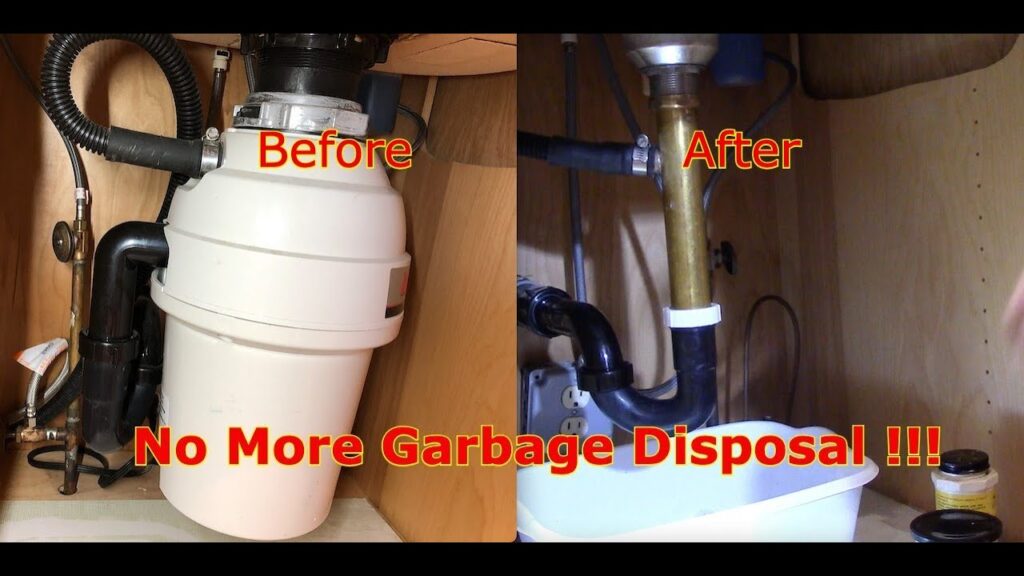To remove a garbage disposal drain, begin by disconnecting power and detaching the drain pipe. Then, unscrew and remove the mounting ring to release the unit.
Removing a garbage disposal drain is a task many homeowners face when upgrading their kitchen or dealing with plumbing issues. It’s a quite straightforward process that involves safety precautions and basic tools. Ensuring the electricity is turned off is paramount to avoid any accidents.
With the necessary wrenches and screwdrivers, you can detach the drain pipe, which is typically connected to the disposal. Once that’s done, you’ll be focusing on the mounting assembly that secures the disposal to the sink. Loosening these components allows for the disposal unit to come off easily. Understanding this procedure is beneficial for effective kitchen maintenance and can save costs on potential plumbing services. By following these simple steps, you’ll navigate this do-it-yourself task with confidence and success.

Credit: www.youtube.com
Safety First: Preparing For The Task
Removal of a garbage disposal drain must begin with safety. Proper preparation ensures a hazard-free and efficient process. We’ll take you through the important safety steps to get ready for this DIY task.
Powering Down: Disconnect The Electricity
Before touching anything, turning off the power is crucial. A live electrical connection poses a serious threat. To prevent any electric shock, cut off the power supply by unplugging the disposal or switching off the breaker.
Tools And Materials Needed
You will need some tools and materials to remove the garbage disposal drain. Gathering these items ahead of time saves effort during the process.
- Adjustable wrench for loosening connections
- Phillips and flat-head screwdrivers for disassembly
- Bucket or pan to catch draining water
- Pliers and pipe wrench for grip and twist
- Tape measure for accuracy
- Non-contact voltage tester for safety check
With these steps followed, you’re now ready to safely embark on removing your garbage disposal drain.
Initial Steps: Clearing The Workspace
Before diving into removing a garbage disposal drain, preparation is key. A clear work area ensures safety and efficiency. Let’s set up your workspace with two straightforward actions.
Emptying The Sink Area
Start with an empty sink. Remove dishes, sponges, and soaps. Clearing these items prevents any obstacles during the process. A tidy space lets you work without interruptions and mishaps.
Positioning A Bucket To Catch Water
Expect some water to spill when detaching the disposal. Place a bucket underneath the pipes. This catches drips and keeps the area dry. A dry floor stops slips and water damage. A bucket also makes cleanup swift.
- Ensure bucket size fits under sink.
- Check the bucket for holes to avoid leaks.
Detach The Garbage Disposal
Removing a garbage disposal can seem daunting. You’ll find that with the right tools, it’s a straightforward task. Follow these steps to detach the unit safely.
Disconnecting Drain Pipes
Start with safety first. Ensure the power supply to the disposal is off. Use a voltage tester to confirm. Here’s what to do next:
- Place a bucket under the pipes. This will catch any water.
- Locate the drain pipe connecting to the disposal.
- Use channel-type pliers to loosen the slip-nut.
- Detach the drain pipe. Set it aside after draining the water.
Unfastening From The Mounting Ring
Now it’s time to remove the disposal from the sink:
- Support the disposal with one hand to prevent it from falling.
- Find the mounting ring.
- Use a screwdriver to turn the mounting ring tabs.
- Lower the disposal carefully. Disconnect the remaining wires and remove any hardware.
A successful detachment means you’re prepared for the installation of a new unit or to patch up the drain should you choose to go without a replacement.
Removing The Mounting Assembly
Removing the mounting assembly from your garbage disposal unit is crucial when you need to replace or fix the unit. Understanding how to safely disassemble this part is the first step in removing the entire garbage disposal system.
Taking Off The Mounting Rings
Start by shutting off the power to the disposal at the breaker box to prevent accidents. Ensure that the power is completely off before proceeding.
- Locate the lower mounting ring which keeps the disposal connected to the sink.
- Use a screwdriver to loosen the screws around the ring.
- After loosening, carefully lower the mounting ring to detach it from the assembly.
With the mounting ring off, the unit will be less secure, so support the disposal with one hand as you work.
Lifting Out The Sink Flange
With the rings removed, focus on the sink flange found at the top of the sink drain.
- Clean around the sink drain to see the flange clearly.
- Use pliers to remove any remaining snap ring.
- Push up on the flange from below the sink to loosen it from the top.
- Pull out the sink flange carefully from above the sink.
Once out, inspect the area for any leftover sealing materials and clean as needed.
After completing these steps, the garbage disposal unit will be detached from the sink, allowing you to proceed with repairs or replacement.
Handling The Drainage Gap
Disconnecting a garbage disposal reveals a gap where water once flowed. Filling this space requires precise steps to ensure a leak-free sink. It’s imperative to address the drainage gap. This guide illustrates how to do this effectively.
Choosing A New Drain Strainer
Finding a proper drain strainer is crucial. Select one that fits snugly into the existing sink hole. Consider the sink’s material and color. Stainless steel strainers often match well with most sinks. Quality matters. Always opt for a durable one that resists corrosion. For the best fit, measure the sink opening or take the old strainer to compare.
Sealing And Installing The New Drain
Installation is straightforward with the right tools and sealant. Plumber’s putty or a silicone sealant provides a watertight seal. Follow these steps:
- Roll the putty into a rope shape.
- Wrap it around the new drain’s underside.
- Press the strainer firmly into the hole.
- From below, tighten the securing nut.
- Remove excess putty or sealant.
- Let the sealant dry as per manufacturer’s instructions.
Perform a water test to check for leaks. Fill the sink and watch for drips underneath. If dry, your sink is ready for use.

Credit: www.reddit.com
Final Touches And Cleanup
After successfully removing your garbage disposal drain, it’s essential to wrap up with precision. Final touches ensure a well-functioning sink, while proper cleanup maintains a neat work area. We’ll guide you through leak testing and plumbing restoration.
Testing For Leaks
With the garbage disposal unit out, checking for leaks is a must. Turn on the water and let it run through the pipes. Observe the connections closely. Look for any water escaping the system. If you spot a drip or a stream, address it immediately. Tighten the fittings or reapply plumber’s tape as needed. Prevention is better than cure!
Restoring The Plumbing System
Restoring your sink’s plumbing is a straightforward task. First, install the new sink drain or reconnect the pipes if not replacing the unit. Ensure every component is secure. Use a wrench but avoid over-tightening which can cause cracks. Once everything is in place, give it one last inspection.
- Clean the work area
- Return any moved items
- Dispose of the old unit responsibly
Congratulations! Your kitchen sink is ready for use, with no more garbage disposal glitches. A job well done!

Credit: www.hgtv.com
FAQs Of How To Remove A Garbage Disposal Drain
How Do You Remove A Drain Pipe From A Garbage Disposal?
To remove a drain pipe from a garbage disposal, first, turn off the power. Next, loosen the clamp on the drain hose and detach it. Finally, twist off the pipe from the disposal unit. Always check for leaks once reassembled.
How Do You Remove A Drain Plug From A Garbage Disposal?
To remove a garbage disposal drain plug, first, ensure the unit is turned off. Use pliers to grip the plug and twist it counterclockwise until it’s free. Pull out the plug gently.
How Do You Remove A Stuck Garbage Disposal Drain?
Turn off the power to the disposal unit. Use an Allen wrench to manually turn the disposal’s flywheel through the bottom hex hole. Dislodge obstructions with a wooden spoon from above. If it remains stuck, press the reset button on the bottom.
Call a professional if these steps fail.
How Do You Unplug A Garbage Disposal Drain?
First, turn off the garbage disposal’s power. Use a wrench to twist the disposal’s bottom hex socket counterclockwise. Push a wooden spoon handle down the drain to dislodge any clogs. Rotate the blades manually if needed. Finally, flush the drain with hot water.
Conclusion
Removing a garbage disposal drain can seem daunting, but with the right tools and steps, it’s achievable. Ensure safety by turning off the power and double-check connections during reassembly.
Remember, regular maintenance can prevent future clogs and extend your disposal’s life.
Ready for a clear sink? Get started now.

